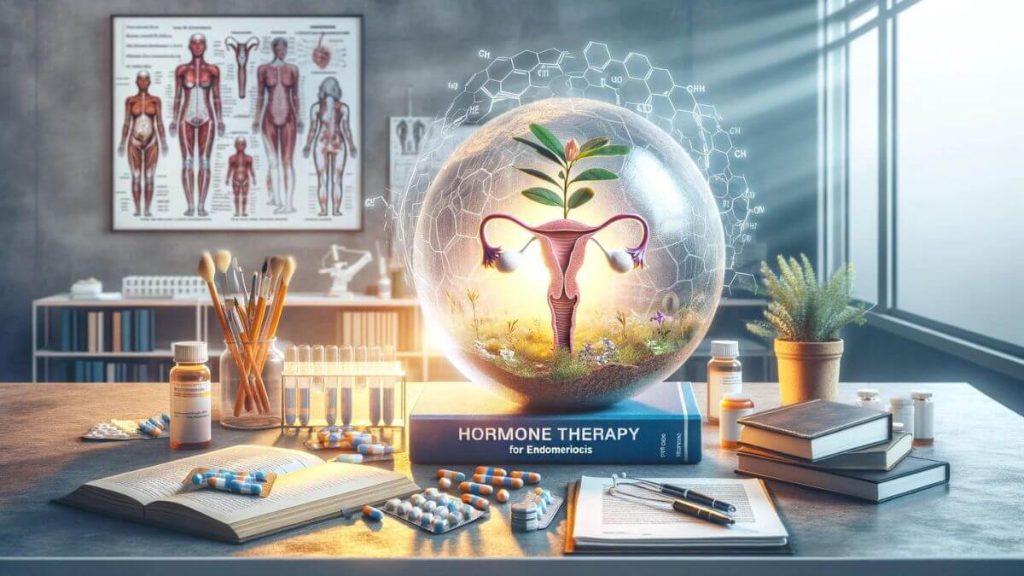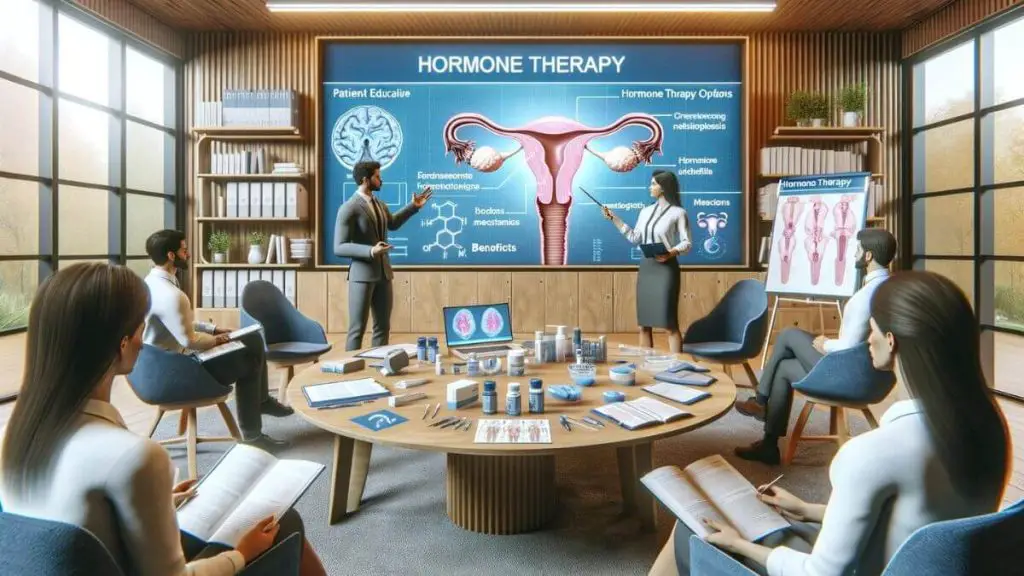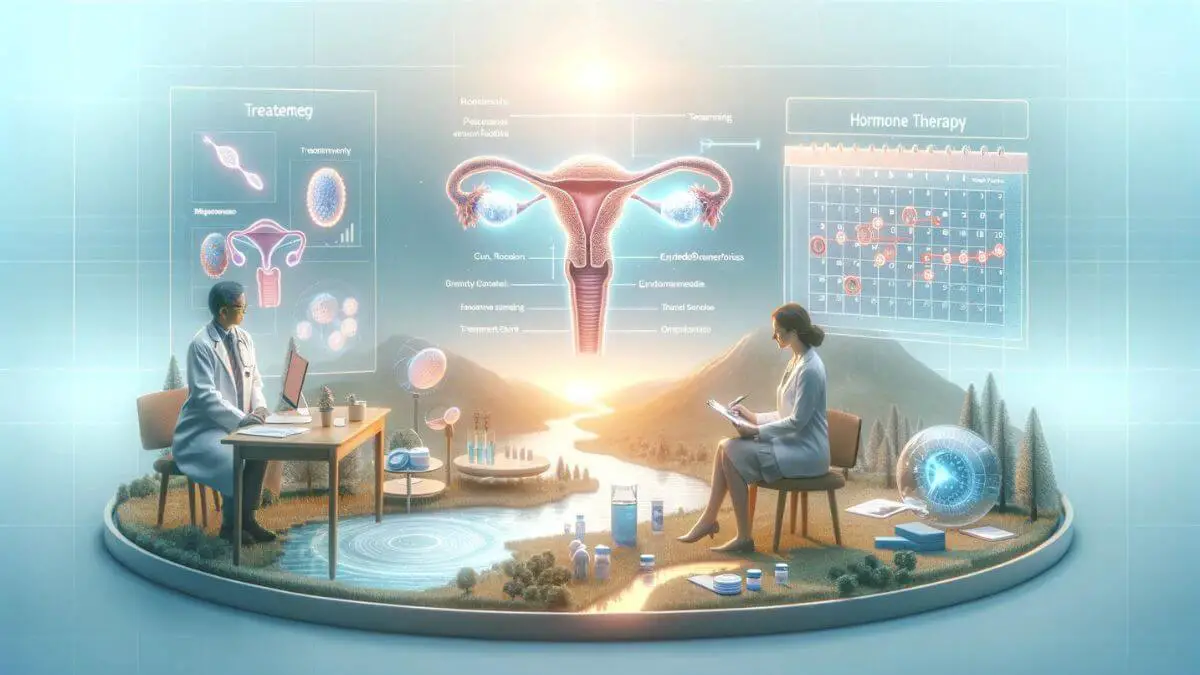Endometriosis and Hormone Therapy Latest Findings
When it comes to endometriosis and hormone therapy latest findings I researched a bit before writing this article. Here’s, in a nutshell, what I found:
Recent studies on endometriosis indicate that hormone therapy, particularly progestin and GnRH analogues, can effectively manage symptoms by reducing estrogen levels, which fuel endometrial tissue growth. Continuous research aims to optimize treatment and minimize side effects.
Now, scroll down to learn more about hormones and therapies…
- Endometriosis and Hormone Therapy Latest Findings
- Understanding Endometriosis and Its Global Impact
- The Role of Hormonal Treatment in Managing Endometriosis
- Challenges in Endometriosis Research and Funding
- Link Between Gut Microbiome and Endometriosis
- Dichloroacetate as A Potential Non-Hormonal Treatment for Endometriosis
- Innovations in Hormonal and Non-Hormonal Therapies for Endometriosis
- The Emergence of Cannabis-Based Therapies in Treatment Trials
- Trailblazing Research and New Drug Targets and Therapeutics
- Advancing Pelvic Floor Therapy for Endometriosis Symptom Management
- Source Links for Endometriosis and Hormone Therapy Latest Findings
Endometriosis and Hormone Therapy Latest Findings
For those grappling with endometriosis, understanding your condition and the vast array of treatment options can be overwhelming.
Recent advances in hormone therapy and endometriosis management provide new hope for the estimated 190 million sufferers worldwide. As you seek relief from the significant pelvic pain, heavy menstrual flow, and fertility issues that often accompany this condition, staying abreast of the latest findings is key to informed healthcare decisions.
From the moment symptoms arise, you may face an exhaustive journey towards diagnosis and effective treatment, typically shrouded by delayed recognition. Now, with emerging hormone therapies carving out new paths, you can envision a life with managed symptoms.
The relentless financial burden, which reaches an astronomical annual estimate of $78-120 billion in the United States alone, underscores the importance of not just any treatment, but the right treatment. Leveraging the latest in medical research to tailor endometriosis management strategies is more consequential than ever.
Step into a world where medical breakthroughs translate into actionable, compassionate care. As you navigate the complex landscape of endometriosis treatment, allow these discoveries to guide you toward reclaiming your health and well-being.

Understanding Endometriosis and Its Global Impact
Endometriosis, often described as a chronic condition, remains a prevalent health challenge with a considerable global impact. As a silent invader, it harbors within the bodies of millions, undermining fertility and fomenting significant economic costs due to healthcare expenditures and loss of productivity.
Your understanding deepens as you peel back the layers of this disease, revealing the intricate struggles with fertility issues and the hindrances posed by diagnostic delays.
Defining Endometriosis: A Chronic Condition Affecting Millions
Picture the uterine tissue, designed to line the womb’s interior, now growing rebelliously outside its sanctioned space. This unwanted proliferation sets off a cascade of discomfort and pain, signaling the presence of endometriosis. Affecting close to 10% of women globally, endometriosis does not discriminate, imparting daily battles against pain and the daunting quest for relief.
If you want to learn more about endometriosis, I wrote an “Endo-Tool, Endometriosis for Men” e-Book.
You can get the 1st Chapter of the e-Book for FREE, and if you like it, you’ll get a Whopping 33% Discount on the Whole Book, plus discounts on other helpful tools. You have nothing to lose but a lot to gain!
The first chapter alone contains all the comprehensive medical knowledge about endometriosis, including:
- What is endometriosis?
- What are the symptoms?
- What causes endometriosis?
- What does endometriosis look like?
- What are the stages?
- What are the types?
- What is adenomyosis and how is it related to endometriosis?
- Why do some women develop severe endo and others don’t?
- Does endometriosis cause infertility?
- How is endometriosis diagnosed?
- Do types and stages affect the treatment?
- Recurrence of endometriosis after excision surgery.
FREE Chapter of “Endo-Tool”
Endometriosis e-Book for Men

Economic and Fertility Implications of Endometriosis
In the financial landscape of healthcare, endometriosis charts are an expensive course. The United States grapples with upwards of $120 billion yearly, tethering personal hardships to national economic burdens. While pocketbooks feel the strain, the familial dream of childbirth dims for many, as endometriosis emerges as a formidable foe against fertility, challenging the hopes of motherhood.
Average Diagnosis Delays and Their Consequences
Riddled by a vexing delay in diagnosis that averages eight years, patients encounter compounding issues. The lag not only accentuates physical and emotional distress but also inflicts additional economic costs as individuals zigzag through the healthcare system in search of answers. Only through the rigors of surgery can the confirmation of the diagnosis be cast, leaving no stone of uncertainty unturned.
In delving into the layers of endometriosis, you’ve encountered the physical toll and fiscal tempests it unleashes. But beyond the individual, it is a clarion call for systems and societies at large to forge pathways toward timely diagnosis, effective treatments, and finally, a world less burdened by the weight of this chronic condition.
| Impact Dimension | Details |
|---|---|
| Global Prevalence | ~10% of reproductive-age women |
| Economic Cost in the U.S. | Approximately $120 billion annually |
| Fertility Challenges | 50% of endometriosis patients face infertility |
| Average Diagnostic Delay | 8 years from onset of symptoms |
The Role of Hormonal Treatment in Managing Endometriosis
For those seeking relief from the debilitating symptoms of endometriosis, hormonal treatment has been a beacon of hope. As a disease fueled largely by estrogen, utilizing hormone-regulating medications plays a pivotal role in endometriosis management. These treatments range from the commonplace, like oral contraceptive pills, to progesterone therapies and even intrauterine devices—each aiming to temper estrogen’s influence on the body.
The primary goal of these hormonal therapies is to reduce the pain and discomfort associated with endometriosis, which can be life-altering. This includes common symptoms such as abdominal and menstrual pain, as well as ancillary discomforts like lower back pain and dyspareunia, a term for painful intercourse.
However, it’s essential to address that while these treatments offer symptomatic relief, their effectiveness does not extend to resolving endometriosis-related infertility. This limitation prompts a continued search for inclusive therapies capable of addressing the broad spectrum of endometriosis complications.
Understanding the scope and limitations of current hormone therapy effectiveness is critical for those affected by endometriosis. While the ongoing pursuit of comprehensive treatment options evolves, hormonal treatments remain a cornerstone for symptom management in this chronic condition.
| Medication Type | Target | Benefits | Limitations |
|---|---|---|---|
| Oral Contraceptives | Estrogen Suppression | Reduced menstrual pain | Does not treat infertility |
| Progesterone Therapy | Estrogen Counterbalance | Improves abdominal pain | May have side effects like weight gain |
| Intrauterine Devices | Localized Hormone Delivery | Decreases non-specific symptoms | Insertion and removal procedures required |
Challenges in Endometriosis Research and Funding
The path to substantial progress in the treatment and understanding of endometriosis is obstructed by a stark discrepancy in research funding, especially when juxtaposed with other major health conditions. This chronic underfunding has been a debilitating hurdle in the quest for innovative treatments and breakthrough discoveries.
Comparing Research Support: Endometriosis vs. Other Conditions
When one studies the landscape of scientific research funding nationally, a concerning pattern emerges.
Diseases with comparable or even lesser societal impacts often garner more attention and financing from institutions like the National Institutes of Health (NIH). This disparity is not just numbers; it represents the inequitable allocation of resources that could potentially transform millions of lives affected by endometriosis through advanced clinical trials and studies.
| Health Condition | NIH Annual Funding (approx.) | Prevalence in the US |
|---|---|---|
| Endometriosis | $10 Million | 1 in 10 women of reproductive age |
| Diabetes | $1 Billion | 34.2 Million |
| Breast Cancer | $750 Million | 1 in 8 women |
The Importance of Increased Funding for Breakthrough Discoveries
Your understanding of the dire need for a paradigm shift in endometriosis funding is crucial. By redirecting and increasing resources, researchers could delve into groundbreaking areas, such as targeting the microflora associated with endometriosis.
This explorative approach draws inspiration from the innovative techniques used in cancer research that have led to life-changing therapies. A surge in funding marks the inception of an era where endometriosis research is not sidelined but is empowered to lead to truly transformative therapies, significantly altering the course of the disease for future generations.
Link Between Gut Microbiome and Endometriosis
The burgeoning field of study examining the gut microbiome has unveiled novel insights into its influence on a host of inflammatory diseases.
This nexus of research progressively mentions the microflora’s dynamic roles within cellular pathophysiology and has initiated a new discourse on potential drug targets for endometriosis. By decoding the intimate linkages within the signaling pathways of gut bacteria, healthcare providers and researchers eye transformative treatment alternatives.
Exploring Potential Drug Targets Within Microflora
As understanding deepens, several components of the gut microbiome have emerged as promising drug targets for mitigating endometriosis.
The capacity of some bacterial species to affect systemic inflammation opens up prospects for targeted therapies.
It is hypothesized that specific bacterial strains could be harnessed to alleviate the inflammatory responses that exacerbate endometriotic lesions. Such microbial agents could become a cornerstone in the future management of endometriosis.
Strategies from Cancer Research Applied to Endometriosis
Harnessing strategies from cancer research, particularly those pertaining to signaling pathways and microenvironment manipulation, provides a strategic framework to approach endometriosis. Advances in cancer therapeutics often involve modulating the microflora to favor anti-tumor activity. Similarly, understanding methods to steer the gut microbiome towards a state less conducive to the development or progression of endometriosis could pave the way for groundbreaking non-hormonal therapies.
| Inflammatory Disease | Microbiome Signature | Impact on Disease Pathophysiology |
|---|---|---|
| Endometriosis | Dysbiotic Microflora | Enhancement of inflammatory response and lesion progression |
| Crohn’s Disease | Decreased Biodiversity | Barrier function impairment and chronic intestinal inflammation |
| Ulcerative Colitis | Microbial Imbalance | Mucosal immune system dysregulation |

Dichloroacetate as A Potential Non-Hormonal Treatment for Endometriosis
As medical science advances in its quest to understand and manage endometriosis, a significant breakthrough has been documented with dichloroacetate – a drug that researchers are tentatively heralding as a groundbreaking non-hormonal therapy. At the University of Edinburgh, meticulous examinations of endometriosis cells have yielded promising results.
Endometriosis’s association with high lactate production within pelvic wall cells has led scientists to a pivotal discovery: dichloroacetate’s ability to markedly decrease this lactate production. This outcome is particularly noteworthy considering the fact that standard treatments often rely on hormonal therapies that are not suitable for all patients and come with a panoply of side effects.
“This discovery ushers in a new era for those struggling with endometriosis. Our clinical trial aims to offer an alternative solution that circumvents the complications associated with hormone-based treatments,” explained the principal researcher.
This advancement positions dichloroacetate as a compelling candidate within the domain of endometriosis interventions—offering renewed hope for effective management of this debilitating disease without reliance on hormonal modulation.
Here’s a snapshot of dichloroacetate’s profile as it stands within current research parameters…
| Aspect | Detail |
|---|---|
| Category | Non-Hormonal Drug |
| Potential Benefits | Reduces lactate production, symptom severity |
| Current Phase | Ongoing Clinical Trial |
| Role in Treatment | Addresses cellular activity related to endometriosis manifestation |
| Status | Emerging Breakthrough Drug |
Innovations in Hormonal and Non-Hormonal Therapies for Endometriosis
The landscape of endometriosis treatment is witnessing a significant transformation with the introduction of both hormonal therapy advancements and non-hormonal drug therapy options. These scientific developments are changing the way healthcare providers approach the treatment efficacy for endometriosis symptoms.

Innovations in Hormonal Treatments and Their Efficacy
Among the range of hormonal therapies, Progesterone Receptor Modulators (PRMs) have shown noteworthy success. They work by targeting the endometrium’s growth, effectively alleviating symptoms such as dysmenorrhea and dyspareunia. Despite the mixed results with Selective Estrogen Receptor Modulators (SERMs), new-generation PRMs are establishing themselves as a credible option, improving the quality of life for many patients.
- Mifepristone: Known for its antiproliferative effects, offering significant symptom relief.
- Gestrinone: Demonstrates capabilities in reducing both the extent of endometrial tissue and associated pain.
Recent Advancements in Non-Hormonal Drug Therapy
Moving away from hormone-centric treatments, recent advancements have highlighted the potential of non-hormonal drug therapy, particularly dichloroacetate’s promising role in reducing lactate levels that are connected with the pathology of endometriosis lesions.
Dichloroacetate’s therapeutic potential showcases a pioneering approach in targeting the metabolic pathways associated with endometriosis, steering clear from the side effects of hormonal treatments.
As you consider your options in the ever-evolving field of endometriosis treatments, it’s crucial to stay informed about both hormonal and non-hormonal therapies. Their potential to enhance your well-being without the compromise of side effects can be the difference in effective symptom management.
| Treatment Type | Key Advantages | Symptoms Targeted |
|---|---|---|
| Progesterone Receptor Modulators | Reduces endometrial growth, lessens hormonal side effects | Dysmenorrhea, Dyspareunia |
| Selective Estrogen Receptor Modulators | Blocks estrogen effects on endometrial tissue | Limited efficacy in treating pain |
| Non-Hormonal Drug Therapy (e.g., Dichloroacetate) | Targets metabolic pathways, no hormonal side effects | Lactate production, Lesion size |
The Emergence of Cannabis-Based Therapies in Treatment Trials
As the medical community continues to seek innovative solutions for endometriosis treatment, the spotlight has turned onto the potential of medical cannabis. In pioneering clinical trials, researchers are delving deep into the anti-inflammatory properties of cannabinoids and their modulation of the endocannabinoid system (ECS).
Here’s how this groundbreaking research could herald a new era in the management of the condition…
The biologically complex ECS plays a pivotal role in regulating inflammation and maintaining homeostasis. With medical cannabis acting on various receptors within this system, its capability to alleviate symptoms such as swelling, pain, and immune responses has garnered considerable interest.
Here are some highlights from ongoing clinical studies:
- Objective Evaluation: Trials focus on quantifying the effectiveness of cannabinoids like CBD and THC in reducing pelvic pain.
- Quality of Life Assessments: Participants report on the impact medical cannabis has on their daily activities and overall well-being.
- Immunological Impact: Studies are looking into how cannabinoids help manage the immune dysfunctions associated with endometriosis.
“This is not just about symptom relief. It’s about understanding how the active compounds of cannabis interact with the biology of endometriosis, potentially offering a more natural, targeted approach to therapy.”
The promise held by these trials lies not only in symptom management but also in the prospect of understanding disease mechanisms better. As we await conclusive results, there is a tangible sense of optimism for what this means for the future of endometriosis care.
Trailblazing Research and New Drug Targets and Therapeutics
Welcome to the cutting-edge biotech innovations where recent advancements in drug development provide new hope for those suffering from endometriosis. In Basel, a biotech startup named FimmCyte has made a significant breakthrough by identifying a protein that is overexpressed in endometriosis lesions, potentially serving as a transformative new drug target.
This discovery has spurred the development of a novel antibody therapy designed specifically to enhance the immune clearance of endometriotic cells.
By honing in on this overexpressed protein, the therapy allows the immune system to more effectively target and eradicate the problematic cells contributing to endometriosis. FimmCyte’s pioneering approach demonstrates a commitment to pushing the boundaries of what’s possible in treatment options for this challenging condition.
The implications of this approach are substantial; preclinical studies in mice have exhibited a reduction in disease burden more effectively than the current hormonal treatments. Remarkably, antibody therapy achieves this without the hormonal side effects that typically accompany conventional treatments, safeguarding ovarian function and maintaining hormonal balance.
Therapies such as the one developed by FimmCyte showcase how biotech innovations can lead to a paradigm shift in the treatment of diseases.
The pursuit of such drug development strategies promises not only to alleviate the symptoms of endometriosis but also to fundamentally change the way we understand and manage immune clearance in the context of this persistent condition.
By staying informed about these advancements, you stand at the forefront of an evolving landscape in healthcare that aims to bring enhanced therapeutic options to millions affected worldwide.
The future looks even brighter as these medical breakthroughs continue to unfold.
| Aspect | Current Hormonal Treatments | FimmCyte’s Antibody Therapy |
|---|---|---|
| Target | Hormonal suppression | Overexpressed protein in endometriosis cells |
| Mechanism | Regulation of estrogen levels | Immune clearance of lesion cells |
| Effect on Hormonal Balance | Can disrupt hormonal balance | Preserves hormonal balance |
| Effect on Ovarian Function | May impact ovarian function | Does not disrupt ovarian function |
| Side Effects | Varies; can be significant | Reduced side effects profile |
| Effectiveness in Preclinical Studies | Moderate | More effective in reducing disease burden |

Advancing Pelvic Floor Therapy for Endometriosis Symptom Management
If you’re navigating the complexities of endometriosis, you might already be familiar with the term ‘pelvic floor therapy.’ This therapeutic approach, rooted in physiotherapy, is gaining recognition for its effectiveness in relieving some of the most challenging symptoms of endometriosis. Particularly, it plays a substantial role in addressing chronic pelvic pain, a common and debilitating symptom that can severely affect your quality of life.
Physiotherapy as a Tool for Addressing Chronic Pelvic Pain
Within the scope of symptom management, the strategic application of pelvic floor physiotherapy has shown a significant impact on chronic pelvic pain.
Your pelvic floor muscles, when involuntary tensed due to endometriosis, can exacerbate pain. Trained physiotherapists specializing in pelvic health can help you practice relaxation techniques and targeted exercises designed to reduce this tension, thereby easing pain and improving overall pelvic function.
The Impact of Pelvic Floor Relaxation Techniques on Symptoms
Recent clinical insights have illuminated the positive outcome that pelvic floor relaxation techniques can have on endometriosis symptoms. These techniques are not just exercises; they encompass a holistic regimen that aims to strengthen and relax your pelvic muscles, yielding a meaningful reduction in discomfort.
Studies make it clear that incorporating pelvic floor therapy into your treatment plan can advance your journey to better managing symptoms such as dyspareunia and chronic pelvic pain, making it a vital component in the comprehensive care for endometriosis.


About Me
Hi, I’m Lucjan! The reason why I decided to create this blog was my beautiful wife, who experienced a lot of pain in life, but also the lack of information about endometriosis and fibromyalgia for men…
